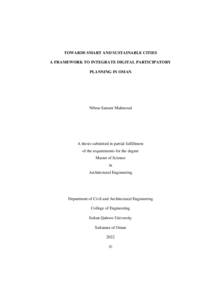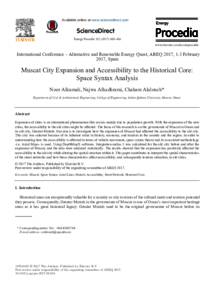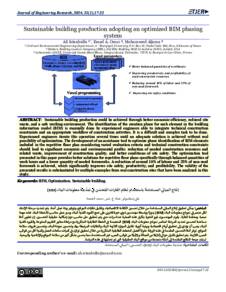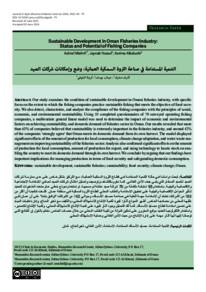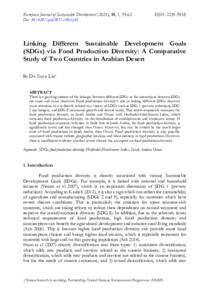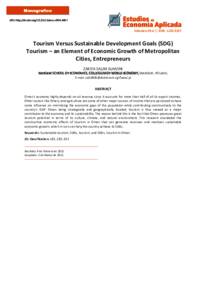وثيقة
Towards smart and sustainable cities : a framework to integrate digital participatory planning in Oman.
عناوين أخرى
نحو مدن مستدامة و ذكية : إطار عمل لدمج المشاركة المجتمعية الرقمية في التخطيط العمراني في عمان
الناشر
Sultan Qaboos University.
ميلادي
2022
اللغة
الأنجليزية
الملخص الإنجليزي
In an ever-changing world with rapid boost of urbanization and population, many cities
are urged to become sustainable and smart cities (SSC), and Oman is not an exception.
The country is aiming to convert the Omani cities into sustainable and smart cities as
part of its vision for 2040. Oman vision 2040 roadmaps the country future for the
coming 20 years and it focuses, through several objectives, on sustainable
development of all the sectors e.g., social, environmental, and economy.
In order to insure a smooth and successful transit towards SSC, a full understanding
for the elements that lead to the successful implementation shall be presented. This
should include not only aspects of environmental and economical sustainability but
also social sustainability which include several elements and pre-requisites. Among
these elements and one of the most important factors is citizens' participation. Many
authors and practitioners interwoven the presence of effective citizens' participation
with the successful implementation of a sustainable and smart city from social
sustainability perspective. Citizens' participation refers to the involvement of the
citizens along with the government in the process of decision making especially when
it comes to the design and the management of a city. Within the smart city context,
Information and Communication Technology (ICT) is employed for fostered and more
effective participation practice in urban planning that is known as Digital Participatory
Planning (DPP).
In Oman, and despite the tendency of the Omani government to achieve SSC, citizens'
participation in urban planning is seldom and limited and current endeavors are still in
the early stages. To avoid failing the implantation of SSC, a proper DPP needs to be
considered henceforth. In response to this need, this research suggests a mechanism to
integrate DPP in the current planning process in Oman. Prior to that, it establishes an
assessment framework for the level of readiness and acceptance among the local
stakeholders –including the government and the society- for the concept of DPP as a
prerequisite for any on-ground DPP implementation.
For doing so, a combination of qualitative and quantitate research methods were
adopted including literature review, pile sorting, semi-structured interviews,
questionnaires, process mapping, and participation experiment using a 3D interactive
digital platform namely "Modelo". Starting with a comprehensive literature review
that was conducted mainly to elicit list of factors and indicators that have direct impact
on the readiness level of the planning stakeholders including the governments, and the
local society. This was followed by pile sorting session with local experts to customize
the suggested framework in a way that ensures it relevancy to the Omani context. After
that, two questionnaires were designed, one for the local citizens and the other for the
concerned planning authorities in Oman. Then the data obtained from both
questionnaires were analyzed statistically using SPSS to assess the level of readiness
for both the government as well as the society for the concept of DPP. The analysis
included descriptive and inferential statistical tests. Simultaneously, key documents
analysis followed by series of interviews with the concerned officials of the planning
authorities were carried out to map out the current planning process that has been
practiced in Oman, based on which a DPP interventions were suggested. Lastly, an
experimental case study was performed wherein engagement of local citizens was
conducted using a digital platform on an ongoing planning project in the Ministry of
Housing and Urban Planning (MoHUP), which helped to identify how feasible of the
suggested DPP process in Oman.
The obtained results showed that the suggested framework by the literature had to be
customized first to fit the Omani context, prior to its utilization in the preparation of
the two questionnaires. The outcome of the two questionnaires revealed that there is
an inventible well among the local citizens to take part in the urban planning issues,
however, more efforts are required to enhance first, the trust between citizens and the
policy makers and second, the internet services through which an effective
participation can occur. Whereas on the government side, the results indicated that
Omani planning authorities have an adequate infrastructure that can enable DPP, yet
experienced administration team is needed. Furthermore, the planners showed a
positive attitude towards DPP, however trust on citizens' comments and opinion shall
be strengthened.
On the other hand, the results of the key document analysis and the interviews showed
that there are four levels of urban planning in Oman that includes national, regional,
structural, and detailed levels. Both the national and regional were finalized and
approved recently and the structural level is under-development. Therefore, the
suggested interventions of DPP are best to be considered for the detailed level during
the time of its development. Henceforth, the process followed in the detailed level of
urban planning were broken-down into steps to identify level, time, and method of
DPP suggested from each step.
The last part of this study focuses on checking the feasibility of applying DPP process
in Oman. To do so, a DPP experiment was conducting by using actual project from
MoHUP and inviting local citizen to participate through a digital participation tool.
The results obtained from the experiment showed that the digital process has met all
the criteria that were set from the literature to be available or considered for successful
digital participation process.
To sum up, this thesis mapped, for the first time, the current planning process in Oman
and introduced a framework to intergrade Digital Public Participation within this
process as a contribution to the move towards sustainable smart cities that are
encouraged by Oman Vision 2040. This framework is a result of four interrelated
studies that form the body of this thesis. These studies developed local criteria to assess
Oman readiness for DPP, assessed the readiness of both the government and the
citizens for DPP, mapped the current planning processes in Oman at four levels, and
tested the feasibility of applying DPP in a real project with real citizens. In the near
further, we hope that the findings of this study will be adopted by the local authorities
and the proposed framework will be tested in a larger scale by the MoHUP.
المجموعة
URL المصدر
الملخص العربي
في عالم دائم التغير والذي يشهد زيادة كبيرة في ظاهرة التمدن الحضري نتيجة الزيادة مستمرة في التعداد السكاني
,هناك العديد من المدن حثت لكي تصبح مدن ذكية و مستدامه و سلطنة عمان ليست استثناء عن تلك المدن . حيث
شهدت البالد وضع الخطوات األولى لتحقيق مدن عمانية مستدامة و ذكية في المستقبل القريب من خالل رؤية
عمان .2040 تلك الرؤية تمثل الرؤية المستقبلية لعمان خالل العشرين سنة القادمة. تتضمن هذه الرؤية عدة أهداف
من بينها إنشاء مدن عمانية ذكية و متسدامة و تحقيق اإلستدامة المجتمعية و اإلقتصادية و البيئية.
من فهم العوامل التي تؤدي الي التطبيق
من أجل ضمان انتقال سلس و ناجح نحو المدن المستدامة الذكية البد أوالا
الناجح لهذه المدن. من بين هذه العوامل ومن أهمها هو المشاركة المجتمعية والتي تعتبر ركيزة أساسية لالستدامة
تخاذ القرارات و خصوصاا المجتمعية. المقصود بالمشاركة المجتمعية هو إشراك المواطنين مع الحكومة في عملية إ
فيما يخص تصميم المدن و إدارتها. ويمتد هذا المفهوم في المدن الذكية ليشمل استخدام التطبيقات الرقمية في
العملية التشاركية وذلك إلتاحة الفرصة ألكبر شريحة من المواطنين بالمشاركة.
على الرغم من أهمية المشاركة المجتمعية الرقمية في تكوين مالمح المدن المستدامة و الذكية إال أنها ما زالت
غير مطبقة في عمان بشكل رسمي. وإذا ما كانت الجهات المعنية ساعية في تحقيق رؤية عمان لسنه 2040 و
تفعيل المشاركة المجتمعية الرقمية في التخطيط إنشاء المدن العمانية الذكية بشكل ناجح و سلس فعليها أ
والا
العمراني. ولكن قبيل التفعيل يجب تقييم مدى استعداد وتقبل كل من الجهات الحكومية المعنية والمواطنين لفكرة
المشاركة المجتمعية الرقمية في التخطيط العمراني.
وعليه فإن هذه الدراسة تهدف الى تحقيق عدة أهداف وهي أوال: تطوير آلية لقياس مدى قبول واستعداد أصحاب
العالقة في التخطيط العمراني لفكرة التخطيط التشاركي الرقمي و ثانيا: استخدام تلك الآلية لقياس مستوى القبول
و الاستعداد لكل من الجهات الحكومية المعنية والمواطنين لفكرة المشاركة المجتمعية الرقمية في التخطيط
ل عملية التخطيط العمراني المتبعة حاليا من قبل وزارة ا العمراني في عمان. يتضمن الهدف الثالث فهم وتحلي
الإسكان و التخطيط العمراني من أجل اقتراح التعديلات اللازمة إلدخال المشاركة المجتمعية الرقمية ضمن
الخطوات المختلفة لعملية التخطيط العمراني. أما الهدف الرابع يتضمن تقييم المشاركة المجتمعية الرقمية المقترحة
من خلال دراسة حاله لإحدى المشاريع الحالية لوزارة الاسكان و التخطيط العمراني العمانية.
من أجل تحقيق تلك االهداف اعتمدت الدراسة على عدد من الطرق البحثية المختلفة و التي شملت بحث الادبيات
المتعلقة بتطبيقات المدن المستدامة و الذكية و محاوله معرفة عناصرها و مكوناتها و علاقتها المباشرة بفكرة
المشاركة المجتمعية وكذلك البحث في فكره المشاركة المجتمعية و فوائدها و تطور طرقها و من بعدها بحث و
التعريف عن سلطنة عمان بشكل عام ثم التطرق الى أهم المساعي الحكومية تجاه التطبيقات اللازمة لإنشاء مدن
مستدامة و ذكية و من ثم التعرف عن كثب عن الجهات الحكومية المعنية بالتخطيط العمراني. و يختتم البحث في
االدبيات من خلال استخلاص أهم العناصر و المؤشرات التي تؤثر على مدى قبول واستعداد كل من الجهات
الحكومية و المواطنين لفكره التخطيط التشاركي الرقمي.
فيما بعد و استنادا على أهم العناصر و المؤشرات التي تؤثر على مدى جهازية واستعداد كل من الجهات الحكومية
و المواطنين لفكره التخطيط التشاركي الرقمي التي تم إستخلاصها من الأدبيات، تم عقد ورشة عمل باستخدام
طريقة الفرز و التقييم التفاعلي Sorting Pile بمشاركة عدد من الخبراء المحليين لتأكيد مدى صلة و تأثير هذه
العوامل و المؤشرات على المجتمع العماني. واستنادا على المؤشرات التي نتجت من ورشة الفرز فقد تم تجهيز
استبيانين إحداهما خاصة بالمواطنين و األخر خاص بموظفي وزارة اإلسكان و التخطيط العمراني حيث تم
الحصول على 280 استبانة مكتملة في االستبيان المجتمعي و 50 استبانة مكتملة في االستبيان الحكومي.
يعتمد البحث أيضا على تحليل المستندات الخاصة بوزارة االسكان والتخطيط العمراني و يليها إجراء مقابلات
فردية مع عدد من موظفين الوزارة من أجل فهم و تحليل عملية التخطيط العمراني المتبعة حاليا من قبل وزارة
الاسكان و التخطيط العمراني. كما تم اختبار جدوى التخطيط التشاركي الرقمي التفاعلي في عمان عن طريق
تطبيق حالة دراسية لمشروع واقعي من وزارة اإلسكان والتخطيط العمراني مع مواطنين عن طريق تطبيق
"موديلو" Modelo.
أظهرت نتائج تحليل األدبيات وجود عدد من العناصر والمؤشرات التي تؤثر بشكل مباشر على مستوى استعداد
أصحاب العالقة بالتخطيط العمراني لفكرة التخطيط التشاركي الرقمي. أما نتيجة جلسة الفرز مع الخبراء المحليين
جاءت لتأكد مدى إرتباط تلك العناصر و المؤشرات بالبيئة العمانية مع إجراء بعض التعديالت البسيطة وإضافة
عناصر أخرى ذات عالقة مباشرة بالمجتمع العماني. أما فيما يخص االستبيانين فقد أظهرت النتائج اإلحصائية
المتعلقة بالمجتمع بأن المواطنين العمانيين لديهم مستوى جيد من الوعي المتعلق بأهمية التخطيط التشاركي الرقمي
كما و أنهم على استعداد للمشاركة فيما لو تبنت الجهات الحكومية المعنية نظام التخطيط التشاركي الرقمي .من
جهة اخرى أظهر نفس االستبيان بأن الثقة ما بين المواطنين و الجهات الحكومية فيما يخص إدراج أراء المشاركين
في عملية اتخاذ القرارات المتعلقة بالتخطيط العمراني يجب أن تكون أقوى وأكبر وخصوصا عند المشاركين من
الرجال. إضافة الى ذلك, فإن غالبية المشاركين عبروا عن مخاوفهم من استعمال معلوماتهم الخاصة عند المشاركة
في النظام الرقمي. تلك المخاوف كانت موجودة بشكل أوضح عند المشاركين ذوي مستوى التعليم المحدود
وأصحاب الدخل المحدود. أخيرا، خدمة األنترنت يجب أن تكون متوفرة بشكل أوسع لتشمل جميع فئات المجتمع
العماني نظرا التخطيط التشاركي الرقمي. ا ألهمية وجود الإنترنت لتفعيل
أما فيما يخص الاستبيان الثاني الخاص بموظفي وزارة الإسكان و التخطيط العمراني فقد أظهرت النتائج بأن
الموظفين بشكل عام لديهم نظرة إيجابية تجاه فكرة التخطيط التشاركي الرقمي باإلضافة الي تأكيد أغلب المشاركين
بأن الوزارة لديها البنى التحتية ال الزمة إلجراء التخطيط التشاركي الرقمي فيما لو تم تفعيل تلك الفكرة في المستقبل
القريب. ومع ذلك فقد جاءت أراء غالبية المشاركين بعدم توفر فريق إداري مختص لدى الوزارة في الوقت الحالي
لإدارة عملية التخطيط التشاركي الرقمي. الثقة أيضا كانت من النقاط التي يجب ان تبذل الوزارة الجهد من أجل
تحسين ثقة الموظفين بالعملية والتي تتضمن معاملة جميع أراء المشاركين بالتساوي.
الجزء الأخير من البحث كان يركز عن جدوى استخدام التخطيط التشاركي الرقمي في عمان من خلال إختيار
مشروع قائم لدى وزارة الإسكان و التخطيط العمراني و دعوة المواطنين للمشاركة في إبداء آرائهم على المشروع
عن طريق برنامج يتيح عملية التخطيط التشاركي الرقمي. أظهرت النتائج المستنبطة من التجربة بتوفر جميع
الاعتبارات الواجب توفرها في اي عملية تخطيط تشاركي رقمي وعليه امكانية اعتماد نفس الآلية في المستقبل
لإجراء تخطيط تشاركي رقمي ناجح.
وعليه، فإن هذا البحث يقدم إطار عمل إلدراج التخطيط التشاركي الرقمي في خطط التخطيط العمراني الحالية
بما يدعم عملية التحول للمدن المستدامة الذكية في عمان والتي شجعت عليها رؤية عمان .2040 يجب على
الأبحاث المستقبلية اختبار إطار العمل الذي تم اقتراحه بشكل أوسع بالتعاون مع الجهات الحكومية المعنية
بالتخطيط العمراني في عمان.
,هناك العديد من المدن حثت لكي تصبح مدن ذكية و مستدامه و سلطنة عمان ليست استثناء عن تلك المدن . حيث
شهدت البالد وضع الخطوات األولى لتحقيق مدن عمانية مستدامة و ذكية في المستقبل القريب من خالل رؤية
عمان .2040 تلك الرؤية تمثل الرؤية المستقبلية لعمان خالل العشرين سنة القادمة. تتضمن هذه الرؤية عدة أهداف
من بينها إنشاء مدن عمانية ذكية و متسدامة و تحقيق اإلستدامة المجتمعية و اإلقتصادية و البيئية.
من فهم العوامل التي تؤدي الي التطبيق
من أجل ضمان انتقال سلس و ناجح نحو المدن المستدامة الذكية البد أوالا
الناجح لهذه المدن. من بين هذه العوامل ومن أهمها هو المشاركة المجتمعية والتي تعتبر ركيزة أساسية لالستدامة
تخاذ القرارات و خصوصاا المجتمعية. المقصود بالمشاركة المجتمعية هو إشراك المواطنين مع الحكومة في عملية إ
فيما يخص تصميم المدن و إدارتها. ويمتد هذا المفهوم في المدن الذكية ليشمل استخدام التطبيقات الرقمية في
العملية التشاركية وذلك إلتاحة الفرصة ألكبر شريحة من المواطنين بالمشاركة.
على الرغم من أهمية المشاركة المجتمعية الرقمية في تكوين مالمح المدن المستدامة و الذكية إال أنها ما زالت
غير مطبقة في عمان بشكل رسمي. وإذا ما كانت الجهات المعنية ساعية في تحقيق رؤية عمان لسنه 2040 و
تفعيل المشاركة المجتمعية الرقمية في التخطيط إنشاء المدن العمانية الذكية بشكل ناجح و سلس فعليها أ
والا
العمراني. ولكن قبيل التفعيل يجب تقييم مدى استعداد وتقبل كل من الجهات الحكومية المعنية والمواطنين لفكرة
المشاركة المجتمعية الرقمية في التخطيط العمراني.
وعليه فإن هذه الدراسة تهدف الى تحقيق عدة أهداف وهي أوال: تطوير آلية لقياس مدى قبول واستعداد أصحاب
العالقة في التخطيط العمراني لفكرة التخطيط التشاركي الرقمي و ثانيا: استخدام تلك الآلية لقياس مستوى القبول
و الاستعداد لكل من الجهات الحكومية المعنية والمواطنين لفكرة المشاركة المجتمعية الرقمية في التخطيط
ل عملية التخطيط العمراني المتبعة حاليا من قبل وزارة ا العمراني في عمان. يتضمن الهدف الثالث فهم وتحلي
الإسكان و التخطيط العمراني من أجل اقتراح التعديلات اللازمة إلدخال المشاركة المجتمعية الرقمية ضمن
الخطوات المختلفة لعملية التخطيط العمراني. أما الهدف الرابع يتضمن تقييم المشاركة المجتمعية الرقمية المقترحة
من خلال دراسة حاله لإحدى المشاريع الحالية لوزارة الاسكان و التخطيط العمراني العمانية.
من أجل تحقيق تلك االهداف اعتمدت الدراسة على عدد من الطرق البحثية المختلفة و التي شملت بحث الادبيات
المتعلقة بتطبيقات المدن المستدامة و الذكية و محاوله معرفة عناصرها و مكوناتها و علاقتها المباشرة بفكرة
المشاركة المجتمعية وكذلك البحث في فكره المشاركة المجتمعية و فوائدها و تطور طرقها و من بعدها بحث و
التعريف عن سلطنة عمان بشكل عام ثم التطرق الى أهم المساعي الحكومية تجاه التطبيقات اللازمة لإنشاء مدن
مستدامة و ذكية و من ثم التعرف عن كثب عن الجهات الحكومية المعنية بالتخطيط العمراني. و يختتم البحث في
االدبيات من خلال استخلاص أهم العناصر و المؤشرات التي تؤثر على مدى قبول واستعداد كل من الجهات
الحكومية و المواطنين لفكره التخطيط التشاركي الرقمي.
فيما بعد و استنادا على أهم العناصر و المؤشرات التي تؤثر على مدى جهازية واستعداد كل من الجهات الحكومية
و المواطنين لفكره التخطيط التشاركي الرقمي التي تم إستخلاصها من الأدبيات، تم عقد ورشة عمل باستخدام
طريقة الفرز و التقييم التفاعلي Sorting Pile بمشاركة عدد من الخبراء المحليين لتأكيد مدى صلة و تأثير هذه
العوامل و المؤشرات على المجتمع العماني. واستنادا على المؤشرات التي نتجت من ورشة الفرز فقد تم تجهيز
استبيانين إحداهما خاصة بالمواطنين و األخر خاص بموظفي وزارة اإلسكان و التخطيط العمراني حيث تم
الحصول على 280 استبانة مكتملة في االستبيان المجتمعي و 50 استبانة مكتملة في االستبيان الحكومي.
يعتمد البحث أيضا على تحليل المستندات الخاصة بوزارة االسكان والتخطيط العمراني و يليها إجراء مقابلات
فردية مع عدد من موظفين الوزارة من أجل فهم و تحليل عملية التخطيط العمراني المتبعة حاليا من قبل وزارة
الاسكان و التخطيط العمراني. كما تم اختبار جدوى التخطيط التشاركي الرقمي التفاعلي في عمان عن طريق
تطبيق حالة دراسية لمشروع واقعي من وزارة اإلسكان والتخطيط العمراني مع مواطنين عن طريق تطبيق
"موديلو" Modelo.
أظهرت نتائج تحليل األدبيات وجود عدد من العناصر والمؤشرات التي تؤثر بشكل مباشر على مستوى استعداد
أصحاب العالقة بالتخطيط العمراني لفكرة التخطيط التشاركي الرقمي. أما نتيجة جلسة الفرز مع الخبراء المحليين
جاءت لتأكد مدى إرتباط تلك العناصر و المؤشرات بالبيئة العمانية مع إجراء بعض التعديالت البسيطة وإضافة
عناصر أخرى ذات عالقة مباشرة بالمجتمع العماني. أما فيما يخص االستبيانين فقد أظهرت النتائج اإلحصائية
المتعلقة بالمجتمع بأن المواطنين العمانيين لديهم مستوى جيد من الوعي المتعلق بأهمية التخطيط التشاركي الرقمي
كما و أنهم على استعداد للمشاركة فيما لو تبنت الجهات الحكومية المعنية نظام التخطيط التشاركي الرقمي .من
جهة اخرى أظهر نفس االستبيان بأن الثقة ما بين المواطنين و الجهات الحكومية فيما يخص إدراج أراء المشاركين
في عملية اتخاذ القرارات المتعلقة بالتخطيط العمراني يجب أن تكون أقوى وأكبر وخصوصا عند المشاركين من
الرجال. إضافة الى ذلك, فإن غالبية المشاركين عبروا عن مخاوفهم من استعمال معلوماتهم الخاصة عند المشاركة
في النظام الرقمي. تلك المخاوف كانت موجودة بشكل أوضح عند المشاركين ذوي مستوى التعليم المحدود
وأصحاب الدخل المحدود. أخيرا، خدمة األنترنت يجب أن تكون متوفرة بشكل أوسع لتشمل جميع فئات المجتمع
العماني نظرا التخطيط التشاركي الرقمي. ا ألهمية وجود الإنترنت لتفعيل
أما فيما يخص الاستبيان الثاني الخاص بموظفي وزارة الإسكان و التخطيط العمراني فقد أظهرت النتائج بأن
الموظفين بشكل عام لديهم نظرة إيجابية تجاه فكرة التخطيط التشاركي الرقمي باإلضافة الي تأكيد أغلب المشاركين
بأن الوزارة لديها البنى التحتية ال الزمة إلجراء التخطيط التشاركي الرقمي فيما لو تم تفعيل تلك الفكرة في المستقبل
القريب. ومع ذلك فقد جاءت أراء غالبية المشاركين بعدم توفر فريق إداري مختص لدى الوزارة في الوقت الحالي
لإدارة عملية التخطيط التشاركي الرقمي. الثقة أيضا كانت من النقاط التي يجب ان تبذل الوزارة الجهد من أجل
تحسين ثقة الموظفين بالعملية والتي تتضمن معاملة جميع أراء المشاركين بالتساوي.
الجزء الأخير من البحث كان يركز عن جدوى استخدام التخطيط التشاركي الرقمي في عمان من خلال إختيار
مشروع قائم لدى وزارة الإسكان و التخطيط العمراني و دعوة المواطنين للمشاركة في إبداء آرائهم على المشروع
عن طريق برنامج يتيح عملية التخطيط التشاركي الرقمي. أظهرت النتائج المستنبطة من التجربة بتوفر جميع
الاعتبارات الواجب توفرها في اي عملية تخطيط تشاركي رقمي وعليه امكانية اعتماد نفس الآلية في المستقبل
لإجراء تخطيط تشاركي رقمي ناجح.
وعليه، فإن هذا البحث يقدم إطار عمل إلدراج التخطيط التشاركي الرقمي في خطط التخطيط العمراني الحالية
بما يدعم عملية التحول للمدن المستدامة الذكية في عمان والتي شجعت عليها رؤية عمان .2040 يجب على
الأبحاث المستقبلية اختبار إطار العمل الذي تم اقتراحه بشكل أوسع بالتعاون مع الجهات الحكومية المعنية
بالتخطيط العمراني في عمان.
قالب العنصر
الرسائل والأطروحات الجامعية

